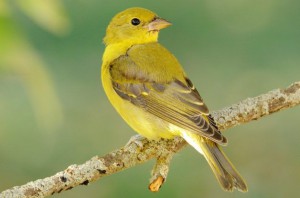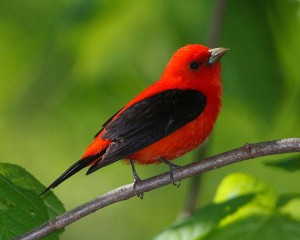

Scarlet Tanager
By Julie Jansen
The premier time to find scarlet tanagers is during the first few days after the males arrive in spring. The males arrive earlier than the females and start singing from the tops of big deciduous trees that are just coming into bloom. The males can see each other easily amid the foliage, and neighbor faces off against neighbor. Each stakes his claim and defends his desired territory against other males. At length, one male drives away all intruders and secures his territory. When a female gets there a few days later, abruptly the sovereign male goes quiet. He does not resume loud, conspicuous singing until nest construction has begun, but only rarely throughout the nesting season does he again sing from treetop perches.
The Dating Game
During the courtship period, a male sings seldom and only short, soft songs. If you are lucky enough to locate a courting pair, you may see the male drop quietly to a perch near the forest floor in a location where the female has an unobstructed view of him. Normally his black wings cover much of his scarlet back, but now he positions his wings outward from his body. The female can't help seeing the dazzling red of his back, bordered by perfectly black wings and tail. He flies from one low perch to another, tracing a large semicircle on the forest floor. At each new landing spot, he pauses, posing like a model for a photo shoot. Overhead, the female traces a similar route, staying above him and watching him closely as he displays.
A female starts building a nest within a week after arrival, without help from the male. She can have the nest done in as little as a day or two, or it may take her up to a week. While she works, the male starts singing loudly again. Occasionally the female sings also. Only the female incubates the eggs. Both parents feed the young, though the male's contribution varies from bird to bird. Nestlings receive caterpillars, adult insects, and fruit. Other frequent menu items include the abdomens of insects, from which the parent has tenderly removed the legs, wings, and heads.
Double Life
The scarlet tanager leads a double life. Every fall, after the breeding season, the entire population picks up and moves to South America. The technical term is "complete migration," meaning that there is no overlap between the summer and winter ranges. Reports in winter reveal them in Colombia, Ecuador, Peru, and Bolivia. Information about their lives in South America is scant, but scarlet tanagers do not breed there. It's thought they spend this second summer singly or in small mixed flocks among mountain forest slopes. There is no evidence of pair bonds in winter. In South America, male scarlet tanagers are not scarlet. Because they do not breed in winter, they don't have to defend territory or engage in courtship. Thus, they have no need for attention-getting plumage. Before they go south, males molt. Their bodies turn green, like females, but their wings remain black. In late summer, you may see a male half molted, with splotchy patches of red and green body feathers. Before their northward spring migration, males molt back to red again. Then they have fresh, unfraied feathers for the arduous flight.
We don't know the details of their route. We do know that most fly across the Gulf of Mexico, a nonstop journey of some 600 miles. Moreover, scarlet tanagers don't start their migration from Central America, the way most neotropical passerine migrants do. They're coming all the way from South America, probably through Venezuela or Colombia.
BirdWatcher's Digest May/June 2020 issue